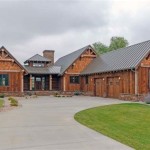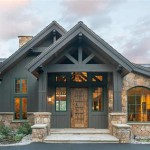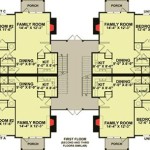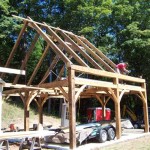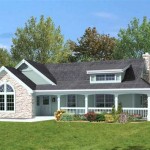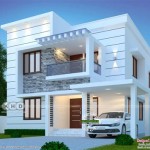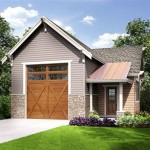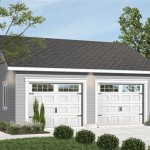Low Country House Plans with Detached Garages: Harmonizing Style and Function
Low Country house plans evoke images of idyllic coastal living, characterized by wide porches, elevated foundations, and a focus on capturing cooling breezes. The addition of a detached garage to these designs introduces a unique blend of architectural charm and practical storage solutions. This article will explore the key elements of Low Country style, the benefits and considerations of incorporating detached garages, and how these two features can cohesively create a comfortable and aesthetically pleasing living environment.
Low Country architecture, originating from the coastal regions of the Southeastern United States, is deeply rooted in functionality and adaptability to the warm, humid climate. Key characteristics of this style include expansive front porches, often wrapping around the entire house; elevated foundations, designed to protect against flooding; large windows and high ceilings to maximize ventilation; and durable materials such as wood siding, brick, and metal roofing. The aesthetic is generally understated and elegant, emphasizing natural light, comfortable living spaces, and a strong connection to the surrounding landscape. Color palettes typically consist of muted tones, reflecting the coastal environment and contributing to a sense of tranquility.
The inclusion of a detached garage within a Low Country house plan offers several advantages. It provides a dedicated space for vehicle storage, workshops, and general storage, freeing up valuable space within the main house. Detached garages can also enhance the curb appeal of the property by adding architectural interest and visual symmetry. Furthermore, separating the garage from the main house can reduce noise and fumes, contributing to a healthier indoor environment. Strategically placed, a detached garage can also define outdoor spaces, creating courtyards or garden areas that extend the living space beyond the confines of the home.
Understanding the Design Considerations of Detached Garages
Integrating a detached garage into a Low Country house plan requires careful consideration of several design factors. The garage should complement the architectural style of the main house, utilizing similar materials, colors, and design details. This ensures a cohesive and harmonious aesthetic. The placement of the garage on the property is also crucial, considering factors such as accessibility, views, and the overall flow of the landscape. A well-placed garage can enhance the functionality and aesthetic appeal of the entire property, while a poorly placed one can detract from both.
The size of the detached garage should be proportionate to the size of the house and the needs of the homeowners. A two-car garage is a common choice, but larger garages may be necessary for multiple vehicles, boats, or recreational equipment. The interior layout of the garage should be carefully planned to maximize storage space and functionality. Considerations should be made for workbench areas, shelving, and other storage solutions. Adequate lighting and ventilation are essential for a comfortable and safe working environment.
Connecting the detached garage to the main house is another important consideration. A covered walkway or breezeway can provide protection from the elements, making it easier to access the garage in inclement weather. Landscaping can also be used to create a seamless transition between the garage and the house, blurring the lines between the built environment and the natural landscape. The goal is to integrate the garage into the overall design of the property in a way that is both functional and aesthetically pleasing.
The materials used for the detached garage should be consistent with those used for the main house. This helps to create a unified and cohesive look. Common materials for Low Country style garages include wood siding, brick, stucco, and metal roofing. The choice of materials will depend on the overall design of the house and the desired aesthetic. It is important to select durable and weather-resistant materials that will withstand the harsh coastal environment.
Benefits of Detached Garages in Low Country Designs
Beyond the functional advantages of storage and vehicle protection, detached garages offer several additional benefits when incorporated into Low Country house plans. One significant advantage is the flexibility they provide in terms of design and placement. Unlike attached garages, which must be directly connected to the main house, detached garages can be positioned anywhere on the property, allowing for greater creativity and customization. This flexibility can be particularly valuable on properties with challenging topography or unique site constraints.
Detached garages can also serve as a buffer between the house and the street, providing added privacy and security. By positioning the garage strategically, it can block views and reduce noise from the street, creating a more peaceful and secluded living environment. This is especially beneficial in densely populated areas or on busy streets. The garage can also be used to screen outdoor living spaces, such as patios and gardens, from the view of neighbors.
Furthermore, detached garages can be designed to accommodate a variety of additional uses. They can be converted into workshops, home offices, guest suites, or hobby rooms. This versatility makes them a valuable asset to any home. By adding insulation, heating, and air conditioning, the garage can be transformed into a comfortable and functional living space that can be used year-round. The possibilities are endless, limited only by the imagination of the homeowner.
Detached garages can also increase the property value of a home. They are a desirable feature for many homebuyers, particularly those with multiple vehicles or a need for extra storage space. A well-designed and well-maintained detached garage can significantly enhance the appeal of a property and make it more attractive to potential buyers. This is especially true in areas where covered parking or storage is at a premium.
Integrating Detached Garages with the Landscape
The landscape surrounding a Low Country house and its detached garage is just as important as the architectural design. The goal is to create a seamless transition between the built environment and the natural environment, blurring the lines between the two. Landscaping can be used to soften the lines of the garage, screen it from view, and create a sense of privacy and seclusion. Native plants are a good choice for Low Country landscapes, as they are well-adapted to the local climate and require minimal maintenance. Trees, shrubs, and ground covers can be used to create a layered landscape that provides visual interest and habitat for wildlife.
Walkways and pathways should be carefully designed to connect the garage to the main house and other areas of the property. These pathways should be functional, safe, and aesthetically pleasing. They can be made of a variety of materials, such as brick, stone, gravel, or concrete. Lighting should be incorporated into the pathways to provide safety and security at night. The lighting should be subtle and unobtrusive, avoiding harsh glare and light pollution.
Outdoor living spaces, such as patios and decks, can be integrated with the detached garage to create a cohesive and functional outdoor environment. The garage can be used to provide shade and shelter for these spaces, making them more comfortable and usable year-round. Outdoor furniture, such as tables, chairs, and lounge chairs, can be arranged to create a relaxing and inviting atmosphere. Outdoor kitchens and fireplaces can also be incorporated into the design to enhance the functionality and enjoyment of the outdoor living spaces.
Drainage is an important consideration in Low Country landscapes, particularly in areas that are prone to flooding. The landscape should be designed to effectively manage stormwater runoff, preventing erosion and protecting the foundation of the house and garage. Rain gardens and other bio-retention features can be used to capture and filter stormwater runoff, reducing the amount of pollutants that enter local waterways. These features can also enhance the beauty and biodiversity of the landscape.
In conclusion, Low Country house plans with detached garages offer a unique blend of architectural charm and practical functionality. By carefully considering the design factors and integrating the garage seamlessly into the landscape, homeowners can create a comfortable, aesthetically pleasing, and valuable living environment that embraces the spirit of the Low Country tradition.

Lowcountry Farmhouse House Plan 3 Bedroom Southern Design

Plan 74001 Farmhouse Country Style Cottage With Detached

House Plans With Detached Garages From Don Gardner Donald A Interactive Llc

Embrace House Plans With Detached Garages The Designers

New Popular House Plans With Detached Garages Dfd

New Popular House Plans With Detached Garages Dfd

Lowcountry Farmhouse House Plan 3 Bedroom Southern Design

House Plans With Detached Garages From Don Gardner Donald A Interactive Llc

Country House Plans With Front Porches

Lowcountry Farmhouse House Plan 3 Bedroom Southern Design

